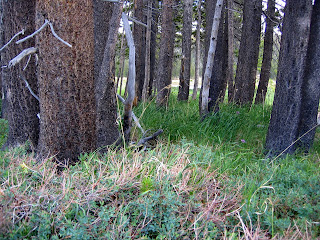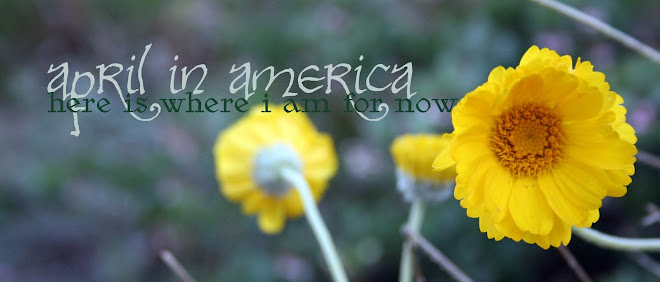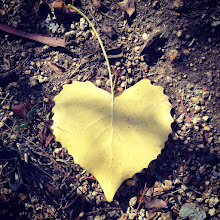skip to main |
skip to sidebar
 This was a tiny islet in the river/creek that runs through Tuolumne Meadows and the nearby backcountry. There hadn't been a lot of snow this past winter, so the river wasn't very high; the island was about two feet above water level. It's wooded with lodge pole pines (Pinus contorta). One in the middle is taller and thicker than the rest, but it looks mostly dead. Maybe an old fire burned it or lightning struck it and the rest--all about the same height and i have no idea how old--have grown since then. The undergrowth is wild onion (smelling it made me hungry!) and two other plants i can't yet identify.
This was a tiny islet in the river/creek that runs through Tuolumne Meadows and the nearby backcountry. There hadn't been a lot of snow this past winter, so the river wasn't very high; the island was about two feet above water level. It's wooded with lodge pole pines (Pinus contorta). One in the middle is taller and thicker than the rest, but it looks mostly dead. Maybe an old fire burned it or lightning struck it and the rest--all about the same height and i have no idea how old--have grown since then. The undergrowth is wild onion (smelling it made me hungry!) and two other plants i can't yet identify.
I sat on the bow of the island to sketch for several hours on a comfy seat of roots and large granite stones, with the sound of the river and my classmates and the warm sun and a cool breeze...it was a lovely day, far from the very crowded Yosemite Valley that most everyone else visits. I must say though, it doesn't very much feel like 'wilderness' when you're only a 45 minute hike from a road and other hikers pass through to other parts of the park.
 This is a photo from Bodie, CA, one of the best-preserved ghost towns in the West. That may be because it was a living town until the 1930's, when an accidentally set fire (don't play with matches!!) burned nearly 95% of the buildings, and it was preserved after that by a family until the state park system purchased it in the 1960's. The town is kept in what the rangers call "a state of arrested decay". They try to keep the town just the way it was when the state parks inherited it. Some buildings are propped up a bit, some of the firewood looks freshly chopped, the meeting hall is a museum and the houses with intact curtains are used as ranger residences, but other than that it is as it was found.
This is a photo from Bodie, CA, one of the best-preserved ghost towns in the West. That may be because it was a living town until the 1930's, when an accidentally set fire (don't play with matches!!) burned nearly 95% of the buildings, and it was preserved after that by a family until the state park system purchased it in the 1960's. The town is kept in what the rangers call "a state of arrested decay". They try to keep the town just the way it was when the state parks inherited it. Some buildings are propped up a bit, some of the firewood looks freshly chopped, the meeting hall is a museum and the houses with intact curtains are used as ranger residences, but other than that it is as it was found.
Bodie looks like people were sucked away by an alien spaceship, leaving clothes on pegs, dishes on the table, suitcases open at the hotels...the reason is that all the roads into or out of town were toll roads. It cost much less to walk out with as little as you needed, or ride a horse out, than to take a wagon or two of your belongings. It even cost less to replace all those belongings wherever you ended up than to pay the tolls to haul them out. That's why so much was left behind.
Bodie was one of the sites where we spent a day to sketch. Because of the streets, hills, rocks and ruins about, it's a fantastic place to practice perspective drawing. On the other hand, if you try to draw things exactly as they are (which we're supposed to be practicing) the buildings look cockeyed, because so few walls, doors, and roofs are at proper right angles anymore. I chose to sketch one of the few buildings that was still pretty straight, from the front, so that i could tell if it was me or the building that was off. :-)
You can find out more about Bodie from this organization or from the state park website. The park is open all year round but the road is not plowed in the winter.
birding life list (in process!)
- White-crowned Sparrow (Zonotrichia ?) in winter
- Western Wood-Pewee (Contopu sordidulus)
- Western Tanager (Piranga ludoviciana)
- Western Scrub Jay (Aphelocoma californica)
- Western Bluebird (Sialia mexicana)
- Tufted Titmouse (Baeolophus bicolor)
- Stellar's Jay (Cyanocitta stelleri)
- Sparkling Violetear (Colibri coruscans)
- Snowy Owl (Nyctea scandiaca)
- Snowy Egret (Egretta thula)
- Ruddy Duck (Oxyura jamaicensis)
- Red-winged Blackbird (Agelaius phoeniceus)
- Red-tailed Hawk (Buteo jamaicensis)
- Pied Crow (Corvus albus)
- Northern Mockingbird (Mimus polyglottos)
- Northern Cardinal (Cardinalis cardinalis)
- Mourning Dove (Zenaida macroura)
- Mallard (Anas platyrhynochos)
- male Superb Sunbird (Cinnyris superbus) i think
- Malachite Kingfisher (Alcedo cristata)
- Lesser Goldfinch, greenbacked (Carduelis psaltria)
- Lazuli Bunting (Passerina amoena)
- Indigo Bunting (Passerina cyanea)
- House Finch (Carpodacus mexicanus)
- Hooded Oriole (Icterus cucullatus nelsoni)
- Greater Roadrunner (Geococcyx califorianus)
- Great Horned Owl (Bubo virginianus)
- Great Blue Heron (Ardea herodias)
- Congo African Grey (Psittacus erithacus erithacus)
- Common Garden Bulbul (Pychonotus barbatus)
- Cinnamon Teal (Anas cyanoptera)
- Cattle Egret (Bubulcus ibis)
- Canada Goose (Branta canadensis)
- California Towhee, juvenile (Pipilo crissalis)
- California Thrasher (Toxostoma redivivum)
- Brown Pelican (Pelecanus occidentalis)
- Blue Jay (Cyanocitta cristata)
- Black-crowned Night-Heron (Nycticorax nycticorax)
- Black-capped Chickadee (Poecile atricapillus)
- Black Phoebe (Sayornis nigricans)
- Black Crowned Waxbill (Estralida nonnula)
- Bald Eagle (Haliaeetus leucocephalus)
- Anna's Hummingbird (Calypte anna)
- American Robin (Turdus migratorius)
- American Kestrel (Falco sparverius)
- American Goldfinch (Carduelis tristis)
- American Coot (Fulica americana)
- American Avocet (Recurvirostra americana)
- African Pygmy-Kingfisher (Ispidina picta)
- Acorn Woodpecker (Melanerpes formicivorus)



